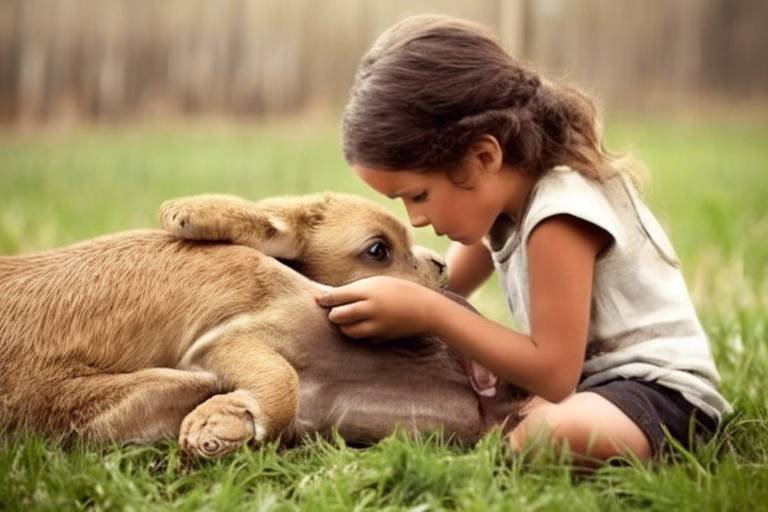Tips for Teaching Children About Animal Welfare
Teaching children about animal welfare is not just a lesson; it's a journey that can shape their understanding of the world and their place in it. By instilling a sense of empathy and responsibility towards animals, we are not only nurturing compassionate individuals but also creating advocates for a better world. Imagine a child who grows up understanding that every living being deserves respect and care—this is the essence of what we aim to achieve when we talk about animal welfare.
So, how do we embark on this journey? The key is to make learning about animal welfare engaging and relatable. Children are naturally curious, and by tapping into that curiosity, we can help them discover the importance of treating animals with kindness. It’s about creating an emotional connection, so they see animals not just as pets or creatures, but as sentient beings with feelings and needs. This understanding lays the groundwork for a lifetime of responsible behavior towards all living things.
One effective way to introduce children to animal welfare is through storytelling. Stories have a magical ability to transport us into different worlds and perspectives. When children read about animals in literature, they can experience their joys and struggles, which fosters a deeper emotional connection. Moreover, discussing the themes of these stories can lead to meaningful conversations about compassion and care. For instance, a book about a rescue dog can open up discussions about the importance of adopting pets in need.
Additionally, incorporating multimedia resources such as videos and documentaries can provide vivid insights into animal welfare issues. These resources can showcase the realities faced by animals in various situations, helping children visualize the concepts they are learning. Seeing the plight of an animal in distress can evoke empathy and motivate them to take action, whether it’s through advocacy or volunteering.
Moreover, hands-on activities can significantly enhance the learning experience. Visiting animal shelters allows children to interact with animals directly, fostering a sense of responsibility and care. Engaging in community service, such as helping at a local animal rescue, teaches them the importance of giving back and making a difference in the lives of animals. These experiences are invaluable in reinforcing the lessons learned about animal welfare.
In summary, teaching children about animal welfare involves a multifaceted approach that combines storytelling, multimedia resources, and hands-on experiences. By making this education engaging and relatable, we can cultivate a generation of compassionate individuals who understand the significance of treating all living beings with kindness and respect.
- Why is teaching children about animal welfare important?
Teaching children about animal welfare is crucial as it fosters empathy, responsibility, and respect for all living beings. It helps them understand the impact of their actions on animals and encourages them to advocate for their rights. - What age is appropriate to start teaching children about animal welfare?
Children can begin learning about animal welfare as early as preschool age. Simple concepts can be introduced through stories and discussions, and as they grow, more complex issues can be addressed. - How can I involve my child in animal welfare activities?
You can involve your child in animal welfare by volunteering at local shelters, participating in community clean-up events, or even fostering pets in need. These activities provide hands-on experience and reinforce the lessons learned.

Understanding Animal Welfare
When we talk about animal welfare, we're diving into a topic that is not only significant for the creatures we share our planet with but also for us as humans. So, what exactly does animal welfare mean? At its core, it refers to the well-being of animals, encompassing their physical and mental health. It's about ensuring that animals are treated with respect and kindness, free from suffering and distress. This concept is essential because it highlights the interconnectedness of all living beings. When animals are cared for properly, it reflects on our humanity and ethical standards.
Understanding animal welfare is crucial for children. It lays a foundation for empathy and responsibility. By grasping the basic needs of animals—such as proper nutrition, shelter, and social interaction—children can start to appreciate the complexities of animal lives. For instance, did you know that animals experience emotions just like we do? They can feel joy, fear, and even sadness. Recognizing this can help children develop a deeper connection with animals and a better understanding of their welfare.
Moreover, the impact of animal welfare extends beyond just the animals themselves. It plays a significant role in our environment and society. For example, when animals are treated poorly, it can lead to ecological imbalances and health issues within communities. This ripple effect emphasizes the importance of teaching children about responsible behavior towards animals. By fostering a sense of responsibility, we can cultivate future generations who are not only aware of animal welfare but are also active advocates for it.
To further illustrate the importance of animal welfare, let's consider a few key components:
- Physical Health: Ensuring animals receive proper veterinary care, nutrition, and living conditions.
- Mental Well-being: Providing enrichment and companionship to prevent boredom and stress.
- Ethical Treatment: Advocating for humane treatment and protection against abuse or neglect.
In summary, understanding animal welfare is a multi-faceted journey that involves recognizing the needs of animals, the ethical implications of our treatment towards them, and the broader impact on society. By teaching children these principles, we not only prepare them to be compassionate individuals but also empower them to make a positive difference in the world.

Encouraging Empathy Towards Animals
Developing empathy is crucial in teaching children about animal welfare. When kids can connect emotionally with animals, they begin to understand their needs and feelings. Imagine a world where children grow up knowing that every creature, big or small, has a story to tell. This emotional connection can be nurtured through various engaging activities that not only educate but also inspire compassion. So, how can we encourage this profound empathy? Let's explore some creative avenues!
Using stories and books about animals can effectively convey messages of compassion and care, making the concept of animal welfare relatable for children. Picture this: a cozy reading nook filled with colorful books featuring brave little animals overcoming challenges. These narratives can open up discussions about the importance of treating animals with kindness. Through the eyes of a character, children can experience the ups and downs of animal life, fostering a deeper understanding of their needs.
Selecting age-appropriate literature that highlights animal welfare themes can inspire children and spark meaningful discussions about the treatment of animals. Books like "Charlotte's Web" or "The One and Only Ivan" not only entertain but also shed light on the realities animals face. By discussing these stories, you can help children reflect on their feelings and the broader implications of animal welfare. It's like planting seeds of empathy that will grow as they read more.
Utilizing videos and documentaries can provide visual insights into animal welfare issues, enhancing children's understanding and emotional connection. Think about how impactful it is to watch a documentary about rescue animals finding their forever homes! Such visuals can evoke emotions that words sometimes can't capture. These resources can serve as powerful tools to illustrate the importance of kindness and responsibility towards animals, making the lessons stick.
Interactive experiences, such as visiting animal shelters or engaging in community service, can reinforce lessons about caring for animals and the importance of welfare. When children see firsthand the conditions animals endure, it can be a real eye-opener. Imagine them volunteering at a local shelter, feeding the animals, or helping with clean-up. These hands-on activities not only teach responsibility but also create lasting memories that shape their understanding of empathy. It's about turning lessons into experiences that resonate deeply within them.
To sum it up, encouraging empathy towards animals is a multifaceted approach that combines storytelling, multimedia resources, and hands-on activities. It's about creating a rich tapestry of experiences that help children grow into compassionate individuals. So, let's embark on this journey together, nurturing the next generation of animal advocates!
- Why is empathy towards animals important? Empathy helps children understand that animals have feelings and needs, promoting kindness and responsible behavior.
- How can I introduce animal welfare concepts to my child? Use storytelling, age-appropriate books, and engaging activities to make the topic relatable and interesting.
- What are some good books for teaching children about animal welfare? Consider titles like "Charlotte's Web," "The One and Only Ivan," and "A Dog's Purpose" for their compelling narratives and themes.
- How can volunteering help children understand animal welfare? Volunteering provides real-life experiences that highlight the importance of caring for animals and the responsibilities involved.
Storytelling and Literature
Storytelling is an age-old tradition that has the power to transport us to different worlds, ignite our imaginations, and teach us valuable lessons. When it comes to educating children about animal welfare, stories can be incredibly effective. They create a bridge between the reader and the animal world, allowing children to see life through the eyes of their furry, feathered, or scaly friends. Have you ever noticed how a good story can make you feel? It can stir emotions, evoke empathy, and inspire action!
Books that focus on animal welfare can introduce children to important themes such as compassion, respect, and responsibility. By engaging with characters who experience challenges and triumphs in their relationships with animals, children can learn about the significance of treating animals with kindness. For instance, a story about a lonely dog waiting at a shelter can spark conversations about adoption and the importance of giving animals a second chance.
When selecting books, it’s crucial to choose age-appropriate literature that resonates with children. Here’s a quick table to guide you in selecting books that highlight animal welfare themes:
| Age Group | Book Title | Author | Key Themes |
|---|---|---|---|
| 3-5 years | The Pigeon Wants a Puppy! | Mo Willems | Desire for companionship |
| 6-8 years | Charlotte's Web | E.B. White | Friendship, sacrifice |
| 9-12 years | War Horse | Michael Morpurgo | Bravery, loyalty |
In addition to traditional books, incorporating multimedia resources can further enrich the learning experience. Watching documentaries or animated films about animal rescue, rehabilitation, and welfare issues can provide children with a visual understanding of the challenges animals face. These resources can evoke emotional responses and make the subject matter more relatable. Imagine a child watching a documentary about a rescue operation for abused animals; it’s an eye-opening experience that can lead to profound discussions about empathy and action.
Ultimately, the combination of storytelling and literature, alongside multimedia resources, creates a powerful learning environment for children. It encourages them to ask questions, express their feelings, and think critically about how they can contribute to animal welfare. So, the next time you sit down with a child, consider sharing a story that opens their heart and mind to the beautiful, yet often challenging, world of animals. It’s a simple yet impactful way to nurture a generation that cares deeply for all living beings.
- Why is storytelling important for teaching children about animal welfare?
Storytelling engages children's emotions and imagination, making complex themes more relatable and easier to understand. - What types of books should I look for?
Choose age-appropriate literature that highlights themes of compassion, responsibility, and the importance of treating animals well. - How can multimedia resources enhance learning?
Visual content, such as documentaries, can provide a deeper understanding of animal welfare issues and evoke empathy.
Choosing the Right Books
When it comes to teaching children about animal welfare, books can be powerful tools. They open up a world of imagination and empathy, allowing young minds to explore the lives of animals in a way that is both engaging and educational. But how do you choose the right books that not only capture their attention but also effectively convey the importance of caring for animals?
First off, consider the age appropriateness of the literature. Books for younger children should be simple and colorful, featuring engaging illustrations and straightforward narratives. For older kids, you can delve into more complex themes that challenge their understanding and encourage critical thinking about animal rights and welfare. Here are some key factors to consider when selecting books:
- Relatable Characters: Look for stories featuring animals that children can connect with emotionally. This connection fosters empathy and understanding.
- Positive Messages: Choose books that promote kindness and compassion towards animals, highlighting the consequences of neglect and abuse.
- Diversity of Perspectives: Select literature that showcases various animals and their environments, helping children understand the broader spectrum of animal welfare issues.
Additionally, don't underestimate the power of illustrated books and picture books. These can be particularly effective for younger readers. They not only tell a story but also visually depict the emotions and struggles of animals, making the message hit home. For instance, a book about a lost dog can teach children about abandonment and the importance of rescue, while a story about a farm can illustrate both the joys and responsibilities of caring for animals.
Furthermore, you might want to explore books that include interactive elements, such as flaps, textures, or even sound buttons. These features can make the reading experience more engaging and memorable, allowing children to immerse themselves in the narrative fully. You could also consider books that come with discussion questions or activities at the end, which can lead to meaningful conversations about animal welfare.
Incorporating a variety of multimedia resources alongside books can enhance understanding. For example, pairing a book about wildlife conservation with a documentary can provide a comprehensive view of the subject. This not only reinforces the lessons learned from the book but also adds a real-world context that can be very impactful.
In summary, choosing the right books is about more than just picking a title off the shelf. It involves selecting stories that resonate with children, promote empathy, and foster a sense of responsibility towards animals. With the right literature, you can inspire the next generation to be compassionate, informed advocates for animal welfare.
Q: How can I encourage my child to read more about animal welfare?
A: Make reading a fun and interactive experience by visiting the library together, setting up a cozy reading nook, and discussing the stories you read. You can also create a reading challenge with rewards to motivate them.
Q: Are there specific authors or series that focus on animal welfare?
A: Yes! Authors like Eric Carle and Patricia Polacco have wonderful books that touch on themes of compassion for animals. Series like "The Animal Rescue Team" also provide engaging stories that promote animal welfare.
Q: How can I integrate discussions about animal welfare with reading?
A: After reading a book, ask open-ended questions about the characters' actions, the animals' feelings, and what your child thinks should happen next. This encourages critical thinking and empathy.
Incorporating Multimedia Resources
In today's digital age, multimedia resources serve as powerful tools for teaching children about animal welfare. Imagine a world where children can not only read about animals but also see their habitats, hear their sounds, and understand their struggles through engaging videos and documentaries. This immersive experience can significantly enhance their understanding and foster a deeper emotional connection with animals.
For instance, watching a documentary about endangered species can open children's eyes to the harsh realities many animals face. It’s one thing to read about deforestation in a book, but it’s entirely different to see the impact on wildlife firsthand through captivating footage. This visual storytelling can evoke empathy and prompt important discussions about conservation and animal rights.
Additionally, interactive videos that include quizzes or activities can make learning about animal welfare fun and engaging. Children can watch a video about how to care for pets and then participate in a quiz that reinforces what they've learned. This combination of viewing and interaction not only makes the learning process enjoyable but also helps solidify their understanding of responsible pet ownership.
Moreover, utilizing online platforms that feature animal welfare organizations can provide children with real-life examples of how they can make a difference. Websites that showcase rescue stories, rehabilitation efforts, and ways to get involved can inspire children to take action. They can learn about volunteering opportunities, fundraising events, or even simple acts of kindness like sharing information about animal welfare on social media.
To further enhance the learning experience, consider creating a
| Resource Type | Title | Age Group | Key Themes |
|---|---|---|---|
| Documentary | The Ivory Game | 10+ | Conservation, Endangered Species |
| Book | Charlotte's Web | 5-12 | Friendship, Compassion |
| Video Series | Animal Rescue | 8+ | Rescue, Care |
| Interactive App | Pet Care 101 | 6-12 | Pet Ownership, Responsibility |
Incorporating these multimedia resources into your teaching strategies can make a world of difference. Not only do they provide visual and auditory stimulation, but they also create an environment where children feel connected to the material. By engaging with various forms of media, children can learn about animal welfare in a way that is both informative and enjoyable, ultimately nurturing a generation that is compassionate and responsible towards all living beings.
- What age is appropriate for teaching children about animal welfare? It's beneficial to start teaching children about animal welfare as early as possible, even as young as 3 years old, using age-appropriate language and resources.
- How can I make learning about animal welfare fun? Incorporate games, interactive videos, and hands-on activities such as visiting shelters or participating in community service.
- Are there specific books or resources you recommend? Yes! Look for literature that highlights animal welfare themes, such as "Charlotte's Web" or documentaries like "The Ivory Game."
- How can I encourage my child to care for pets responsibly? Involve them in daily pet care routines and educate them about the responsibilities that come with pet ownership.
Hands-On Activities
This article provides practical strategies for educating children on the importance of animal welfare, fostering empathy, and encouraging responsible behavior towards animals.
Exploring the concept of animal welfare, its significance, and how it impacts both animals and humans can lay a strong foundation for children's understanding.
Developing empathy is crucial in teaching children about animal welfare. Engaging activities can help children connect emotionally with animals and understand their needs.
Using stories and books about animals can effectively convey messages of compassion and care, making the concept of animal welfare relatable for children.
Selecting age-appropriate literature that highlights animal welfare themes can inspire children and spark meaningful discussions about the treatment of animals.
Utilizing videos and documentaries can provide visual insights into animal welfare issues, enhancing children's understanding and emotional connection.
When it comes to teaching children about animal welfare, play a pivotal role. They provide a tangible way for kids to experience the realities of caring for animals. Imagine the joy on a child's face when they get to interact with animals directly! Activities like visiting animal shelters or volunteering at local rescues can create lasting memories and instill a sense of responsibility. For instance, when children spend time at shelters, they not only learn about the needs of animals but also witness firsthand the impact of neglect and abuse. This experience can be a powerful motivator for them to advocate for animal rights.
In addition to shelter visits, organizing community service events focused on animal welfare can be incredibly engaging. Children can participate in activities such as:
- Organizing a pet food drive to support local animal shelters.
- Creating care packages for rescued animals.
- Helping to clean and maintain animal habitats in local parks or shelters.
These activities do more than just teach children about animal welfare; they also foster a sense of community and teamwork. Moreover, when children work together toward a common goal, they learn valuable life skills such as communication and collaboration.
Another fantastic hands-on approach is to incorporate animal care into everyday life. For example, if your family has pets, involve your children in their daily care routines. This includes feeding, grooming, and exercising the animals. By participating in these tasks, children can learn about the commitment required to care for pets, reinforcing the message that animals are not just playthings but living beings that require love and attention.
Overall, hands-on activities are a fun and effective way to teach children about animal welfare. They provide real-life experiences that can shape their attitudes and behaviors towards animals, making the lessons learned more impactful and memorable.
Teaching children about the responsibilities of pet ownership can instill a sense of accountability and respect for animals in their care.
Guiding children in selecting a pet that matches their lifestyle and capabilities is essential in fostering responsible ownership and care.
Involving children in daily pet care routines helps them understand the commitment required for animal welfare and nurtures a sense of responsibility.
Q: How can I get my child interested in animal welfare?
A: Start by introducing them to books and stories about animals, then involve them in hands-on activities like visiting shelters or volunteering.
Q: What age is appropriate to start teaching children about animal welfare?
A: You can begin as early as preschool age by using simple stories and engaging activities that foster empathy and understanding.
Q: How can I ensure my child understands the seriousness of animal welfare?
A: Discuss real-life examples, watch documentaries together, and encourage discussions about the importance of treating animals with kindness and respect.

Promoting Responsible Pet Ownership
Teaching children about responsible pet ownership is not just about having a cute furry friend at home; it's about instilling a sense of accountability and respect for the lives of animals. When kids understand that pets are not toys but living beings with feelings and needs, they begin to appreciate the responsibilities that come with pet ownership. This foundational understanding can shape their attitudes towards animals for a lifetime.
One of the first steps in promoting responsible pet ownership is guiding children in choosing the right pet. It's essential to consider factors such as the child's age, lifestyle, and the pet's needs. For instance, a high-energy dog may require more exercise and attention than a cat, which might be more independent. By discussing these aspects, children learn to make informed decisions that lead to a better match between them and their pets. This not only enhances the bond but also reduces the likelihood of pets being abandoned or neglected.
Involving children in daily care routines is another critical aspect of responsible pet ownership. When children participate in feeding, grooming, and exercising their pets, they gain firsthand experience of what it takes to care for another living being. This engagement fosters a sense of responsibility and helps children understand the commitment required for animal welfare. It’s like learning to ride a bike; you can read about it all day, but until you hop on and pedal, you won’t truly grasp what it entails.
Moreover, discussing the financial responsibilities associated with pet ownership can also be enlightening. Pets require food, veterinary care, and sometimes even special equipment. By introducing children to the costs involved, they can better appreciate the commitment and planning necessary for responsible pet ownership. For example, you might create a simple budget table that outlines basic expenses:
| Expense | Estimated Cost |
|---|---|
| Food | $30/month |
| Veterinary Care | $50-100/year |
| Grooming | $20-50/month |
| Supplies (toys, beds, etc.) | $10-30/month |
Finally, discussing the importance of adoption can further enrich children's understanding of animal welfare. By adopting pets from shelters, children learn about giving animals a second chance and the significance of reducing overpopulation. This conversation can lead to profound discussions about compassion and the role each individual plays in improving the lives of animals in their communities.
In conclusion, promoting responsible pet ownership is a multifaceted approach that requires patience, education, and hands-on experiences. By guiding children through the journey of pet ownership, from choosing the right pet to understanding daily care and financial responsibilities, we can help them develop a lifelong respect for animals. This not only benefits the pets they care for but also nurtures a generation that values compassion and empathy towards all living beings.
- What is the best age for a child to get a pet? It varies, but generally, children aged 6 and up can take on some responsibilities, with adult supervision.
- How can I teach my child about pet care? Involve them in daily routines like feeding, grooming, and walking the pet.
- What should I consider before adopting a pet? Consider your family's lifestyle, the pet's needs, and the long-term commitment involved.
- Are there specific pets that are better for children? Yes, some pets like certain breeds of dogs and cats are known to be more patient and gentle with kids.
Choosing the Right Pet
Choosing the right pet is not just about picking the cutest animal you see; it's a significant decision that can impact both the child and the animal's life. When children are involved in the decision-making process, it’s essential to guide them through the various considerations that come with pet ownership. Just like selecting a partner for a dance, finding the right pet requires compatibility, understanding, and a bit of research.
First, it's crucial to assess the child's lifestyle and interests. Does your child have the energy to engage with a playful puppy, or would they prefer the calm demeanor of a cat? Understanding the different needs and temperaments of pets can help make the right choice. For instance, some pets require more attention and exercise, while others may be more independent. A dog, for instance, might need daily walks and playtime, while a fish can thrive in a well-maintained tank with minimal interaction.
Moreover, consider the age and maturity of the child. Younger children might not yet be ready for the responsibility that comes with a high-maintenance pet. In contrast, older kids may be eager to take on more duties, such as feeding, grooming, and training. It's also beneficial to discuss the lifespan of different pets, as some animals, like turtles or parrots, can live for decades, requiring a long-term commitment from the family.
To help visualize the options, here’s a simple table comparing some common pets based on their needs and suitability for children:
| Pet Type | Care Level | Activity Level | Best Age Group |
|---|---|---|---|
| Dog | High | High | 8+ |
| Cat | Medium | Medium | 6+ |
| Fish | Low | Low | All Ages |
| Hamster | Low | Medium | 5+ |
| Rabbit | Medium | Medium | 8+ |
In addition to lifestyle and care needs, it’s essential to consider any allergies or sensitivities the child may have. Some pets, like cats and certain dog breeds, can trigger allergic reactions in sensitive individuals. So, before bringing a new furry friend home, a trial period or spending time with the pet at a friend's house can be a wise step to ensure compatibility.
Ultimately, the goal is to foster a loving and responsible relationship between the child and their chosen pet. By involving children in the process of choosing the right pet, you not only teach them about animal welfare but also instill a sense of responsibility and empathy that will last a lifetime. Remember, the right pet can bring immense joy and companionship, but it’s a partnership that requires commitment, understanding, and love.
- What factors should I consider when choosing a pet for my child? Consider your child's age, lifestyle, activity level, and any allergies they may have.
- How can I prepare my child for the responsibilities of pet ownership? Involve them in the research and decision-making process, and discuss daily care routines together.
- Are there pets that are better suited for young children? Yes, smaller pets like hamsters or fish are often easier for younger children to manage.
- How can I ensure a good match between my child and the pet? Spend time together with potential pets before making a decision, and discuss the pet's needs and characteristics.
Daily Care Routines
When it comes to teaching children about animal welfare, are not just a chore; they are a vital lesson in responsibility and empathy. Imagine your child waking up each morning, ready to take on the world, but before they rush into their day, they pause to check on their furry friend. This simple act can set the tone for their entire day, instilling a sense of duty and care that will resonate throughout their lives. By engaging children in daily pet care, we help them understand that animals are not just playthings; they are living beings that depend on us for their well-being.
Incorporating daily routines can be both fun and educational. For instance, feeding a pet at the same time every day teaches children about consistency and the importance of meeting an animal's basic needs. It’s not just about tossing food in a bowl; it’s an opportunity to discuss why pets need a balanced diet and how it affects their health. You might say, "Just like we need fruits and veggies to grow strong, our pets need their food to stay healthy!"
Moreover, involving children in grooming tasks can be a delightful bonding experience. Brushing a dog or cat helps them understand the importance of hygiene and care. You can turn it into a game by timing how long it takes to give their pet a good brush or creating a reward system for consistent care. This way, children learn that grooming is not just about appearance; it’s about keeping pets comfortable and happy. For example, you could explain, "When we brush Fluffy, we're not just making her look good; we’re also helping her feel good!"
Additionally, teaching children about exercise routines for pets is crucial. A dog needs walks, a cat may enjoy playtime, and even small pets benefit from some activity. This can be a fantastic way to encourage kids to be active themselves! You could set up a schedule where they take turns walking the dog or playing with the cat. This not only promotes physical health for both the child and the pet but also emphasizes the importance of regular exercise in maintaining a happy, healthy animal.
To help visualize these routines, consider creating a simple chart that outlines daily tasks. This can include feeding times, grooming schedules, and exercise activities. A table like the one below can serve as a great reference:
| Task | Frequency | Time | Responsible Child |
|---|---|---|---|
| Feed the pet | Daily | 8:00 AM | Child 1 |
| Walk the dog | Daily | 6:00 PM | Child 2 |
| Groom the pet | Weekly | Saturday | Child 1 |
| Playtime | Daily | After School | Child 2 |
By establishing a routine, children will not only learn the practical aspects of caring for an animal but also develop a deeper emotional connection with their pets. They will begin to see their furry companions as part of the family, deserving of love and attention. So, the next time you catch your child happily engaged in their pet’s care, remember that you’re not just teaching them about animal welfare; you’re nurturing a compassionate heart that will carry these values into adulthood.
- What age should I start teaching my child about animal care?
It's never too early! Even toddlers can learn simple tasks like feeding or gently petting an animal. - How can I make pet care fun for my child?
Turn routines into games, use charts, or set up a reward system for consistent care. - What if my child is afraid of animals?
Start with small, gentle animals and allow them to interact at their own pace, gradually building their confidence. - How do I know if my child is ready for a pet?
Assess their maturity and willingness to take on responsibilities. A trial period with a friend's pet can also be helpful.
Frequently Asked Questions
- Why is it important to teach children about animal welfare?
Teaching children about animal welfare is essential because it fosters empathy and compassion. When kids understand the needs and feelings of animals, they are more likely to treat them with kindness and respect. This not only benefits animals but also helps children develop a sense of responsibility and ethics that can carry over into other areas of their lives.
- What are some effective ways to encourage empathy towards animals?
There are many engaging activities that can help cultivate empathy in children. Storytelling and literature are powerful tools; books that highlight animal experiences can create emotional connections. Additionally, hands-on activities, like visiting animal shelters or volunteering, allow children to see firsthand the importance of caring for animals, making the lessons more impactful.
- How can I choose the right books for my child about animal welfare?
Selecting age-appropriate literature is key. Look for stories that feature animals as characters and emphasize themes of kindness and care. Books with illustrations can also make the stories more engaging. Consider discussing the book with your child after reading to spark conversations about animal welfare and their thoughts on the topics presented.
- What multimedia resources are available to teach children about animal welfare?
Utilizing videos and documentaries can be a fantastic way to enhance your child's understanding of animal welfare issues. Look for age-appropriate films that showcase real-life stories of animals in need or highlight conservation efforts. These visual resources can create a lasting emotional impact and inspire children to take action.
- How can I promote responsible pet ownership among my children?
Start by discussing the responsibilities that come with having a pet, such as feeding, grooming, and exercising them. Involve your children in daily care routines to help them understand the commitment required. This hands-on experience not only teaches them about responsibility but also helps them bond with their pets, reinforcing the importance of animal welfare.
- What should I consider when helping my child choose a pet?
When guiding your child in selecting a pet, consider their lifestyle, living space, and ability to care for the animal. Discuss the needs of different types of pets, including their activity levels and care requirements. This ensures that the pet will be a good fit for your family and that your child will be able to provide the necessary care.



















